网络流24题 II
BB
赶作业更新慢了点QAQ
Introduction
本次不包含24题中的三道题目,分别为:《机器人路径规划问题 》(不知道咋做+没题解),《深海机器人问题》(与《火星探险》解法类似),《最长k可重线段集问题》(投影到x轴后与《最长k可重区间集问题》相同,需要特判垂直于x轴的情况)
最长不下降子序列问题 - luogu P2766
Description
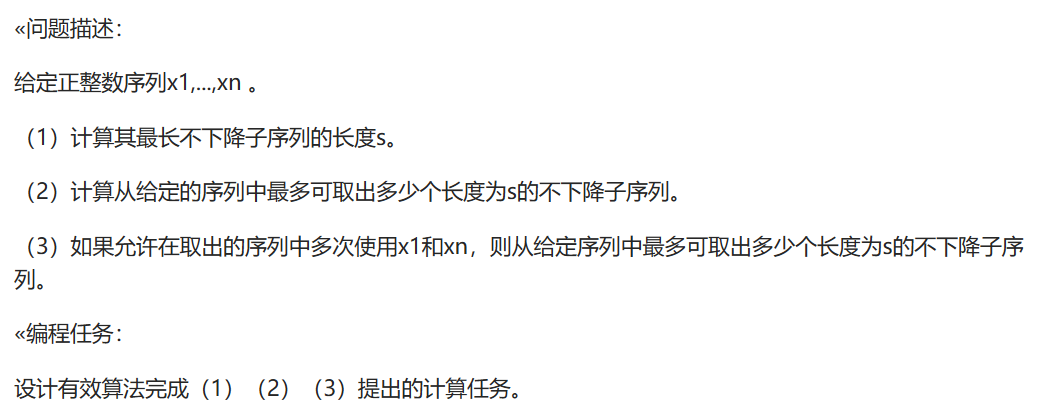 Sample Input
Sample Input
4
3 6 2 5
Sample Output
2
2
3
Solution - 二分图最大匹配
第一问:裸的LIS
第二问:建图
S -> {i}, cap = 1: f[i] = 1
{j} -> {i}, cap = 1: i > j, f[i] = f[j] + 1, a[i] >= a[j]
{i} -> T, cap = 1: f[i] = lis
跑最大流即可
这里的f[i]是指以a[i]结尾的序列的lis为f[i],要使能够取出长度为lis的序列,对于a[i]而言,其只能接在满足f[i] = f[j] + 1, a[i] >= a[j]的元素a[j]之后,否则会使得长度取不到lis
第三问:在第二问的基础上建图
S -> {1}, cap = inf
{n} -> T, cap = inf: f[n] = lis
显然,取消a[1]与a[n]限制即可
int main() {
ios::sync_with_stdio(false);
cin.tie(0);
cout.tie(0);
int n;
cin >> n;
for(int i = 1; i <= n; i++) {
cin >> a[i];
}
for(int i = 1; i <= n; i++) {
for(int j = 0; j < i; j++) {
if(a[i] >= a[j]) {
f[i] = max(f[i], f[j] + 1);
}
}
}
int lis = *max_element(f + 1, f + 1 + n);
cout << lis << "\n";
init();
int ss = 0, tt = 2001;
for(int i = 1; i <= n; i++) {
if(f[i] == 1) {
addEdge(ss, i, 1);
}
if(f[i] == lis) {
addEdge(i + 1000, tt, 1);
}
addEdge(i, i + 1000, 1);
}
for(int i = 1; i <= n; i++) {
for(int j = i + 1; j <= n; j++) {
if(f[i] + 1 == f[j] && a[i] <= a[j]) {
addEdge(i + 1000, j, 1);
}
}
}
int max_flow = ISAP(2 * n + 2, ss, tt);
cout << max_flow << "\n";
init();
for(int i = 1; i <= n; i++) {
if(f[i] == 1) {
addEdge(ss, i, 1);
}
if(f[i] == lis) {
addEdge(i + 1000, tt, 1);
}
addEdge(i, i + 1000, 1);
}
for(int i = 1; i <= n; i++) {
for(int j = i + 1; j <= n; j++) {
if(f[i] + 1 == f[j] && a[i] <= a[j]) {
addEdge(i + 1000, j, 1);
}
}
}
addEdge(ss, 1, inf);
addEdge(1, 1 + 1000, inf);
if(f[n] == lis) {
addEdge(n, n + 1000, inf);
addEdge(n + 1000, tt, inf);
}
max_flow = ISAP(2 * n + 2, ss, tt);
cout << max_flow << "\n";
}
试题库问题 - luogu P2763
Description
 Sample Input
Sample Input
3 15
3 3 4
2 1 2
1 3
1 3
1 3
1 3
3 1 2 3
2 2 3
2 1 3
1 2
1 2
2 1 2
2 1 3
2 1 2
1 1
3 1 2 3
Sample Output
1: 1 6 8
2: 7 9 10
3: 2 3 4 5
Solution
与《圆桌问题》相同,故不赘述
餐巾计划问题 - luogu P1251
Description
 Sample Input
Sample Input
3
1 7 5
11 2 2 3 1
Sample Output
134
Solution
此题的确想不太到 QAQ
将点i拆为i与i',建图
{i'} -> T, cap = ri, cost = 0,满流代表毛巾供应ok,因此需要考虑i'的流入问题
S -> {i'}, cap = inf, cost = p,代表买新毛巾
{i} -> {(i + m)'}, cap = inf, cost = f,代表快洗
{i} -> {(i + n)'}, cap = inf, cost = s,代表慢洗
{i} -> {i + 1}, cap = inf, cost = 0,代表屯旧毛巾
S -> {i}, cap = ri, cost = 0,代表每天产生的旧毛巾
跑MCMF即可
int main() {
ios::sync_with_stdio(false);
cin.tie(0);
cout.tie(0);
init();
int n, a, d1, b, d2, c;
cin >> n;
for(int i = 1; i <= n; i++) {
cin >> r[i];
}
cin >> a >> d1 >> b >> d2 >> c;
int ss = 0, tt = 2 * n + 1;
for(int i = 1; i <= n; i++) {
addEdge(ss, i, r[i], 0);
addEdge(ss, i + n, inf, a);
if(i + 1 <= n) {
addEdge(i, i + 1, inf, 0);
}
if(i + d1 <= n) {
addEdge(i, i + d1 + n, inf, b);
}
if(i + d2 <= n) {
addEdge(i, i + d2 + n, inf, c);
}
addEdge(i + n, tt, r[i], 0);
}
pair<int, ll> ans = solve(ss, tt, tt + 1);
cout << ans.second << "\n";
}
软件补丁问题 - luogu P2761
Description
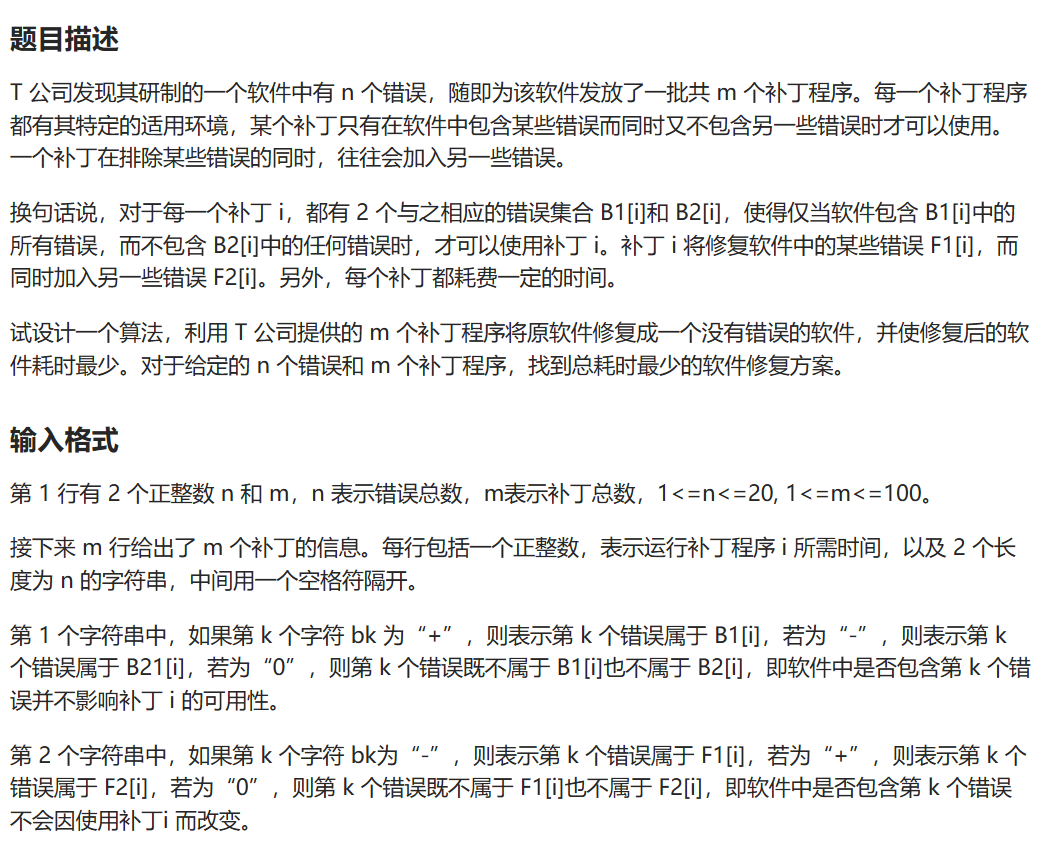 Sample Input
Sample Input
3 3
1 000 00-
1 00- 0-+
2 0-- -++
Sample Output
8
Solution
显然是状压搜索
注意不要一次性构图,会MLE QAQ
#include <bits/stdc++.h>
typedef long long ll;
using namespace std;
const int N = (int)(1 << 20) + 15;
const int inf = 0x3f3f3f3f;
int b1[105], b2[105], f1[105], f2[105], weight[105];
int d[N];
void dijkstra(int src, int des, int m) {
memset(d, 0x3f, sizeof(d));
d[src] = 0;
priority_queue<pair<int, int>, vector<pair<int, int> >, greater<pair<int, int> > > que;
que.push(make_pair(0, src));
while(!que.empty()) {
pair<int, int> ele = que.top();
que.pop();
int u = ele.second, w = ele.first;
if(w > d[u]) {
continue;
}
if(u == des) {
return;
}
for(int j = 1; j <= m; j++) {
if((u & b2[j]) == 0 && (u & b1[j]) == b1[j]) {
int v = (u & ~f1[j]) | f2[j];
int w = weight[j];
if(d[v] > d[u] + w) {
d[v] = d[u] + w;
que.push(make_pair(d[v], v));
}
}
}
}
}
int main() {
ios::sync_with_stdio(false);
cin.tie(0);
cout.tie(0);
int n, m;
cin >> n >> m;
for(int j = 1; j <= m; j++) {
string b, f;
cin >> weight[j] >> b >> f;
for(int i = 0; i < n; i++) {
if(b[i] == '+') {
b1[j] |= (1 << i);
} else if(b[i] == '-') {
b2[j] |= (1 << i);
}
if(f[i] == '+') {
f2[j] |= (1 << i);
} else if(f[i] == '-') {
f1[j] |= (1 << i);
}
}
}
dijkstra((1 << n) - 1, 0, m);
int res = d[0];
cout << (res == inf ? 0 : res) << "\n";
}
[CTSC1999]家园 - luogu P2754
Description
 Sample Input
Sample Input
2 2 1
1 3 0 1 2
1 3 1 2 -1
Sample Output
5
Solution
可以发现,如果按时间拆点后枚举时间,那么第一次能够跑满流的层次,即使最短时间
因此魔改ISAP后暴力枚举加点加边,在残留网络中跑最大流即可
至于无解这个问题,实质上可以设置一个阈值,如到达这一阈值后还未满流则认为无解(算错阈值TLE了好几发 QAQ)
vector<int> hp[N];
int p[N], c[N];
int main() {
ios::sync_with_stdio(false);
cin.tie(0);
cout.tie(0);
init();
int n, m, k;
cin >> n >> m >> k;
int ss = N - 2, tt = N - 1;
for(int i = 1, k; i <= m; i++) {
cin >> c[i] >> k;
while(k--) {
int v;
cin >> v;
hp[i].push_back(v == -1 ? n + 1 : v);
}
}
addEdge(ss, 0, k);
int sum = 0;
int ans = 0;
for(int j = 0; j < 300; j++) {
for(int i = 0 + j * (n + 2); i <= n + 1 + j * (n + 2); i++) {
addEdge(i, i + (n + 2), inf);
}
for(int i = 1; i <= m; i++) {
int u = hp[i][p[i]] + j * (n + 2);
p[i] = (p[i] + 1) % hp[i].size();
int v = hp[i][p[i]] + (j + 1) * (n + 2);
addEdge(u, v, c[i]);
}
addEdge(n + 1 + (j + 1) * (n + 2), tt, inf);
d[n + 1 + (j + 1) * (n + 2)] = 0;
sum += ISAP(N - 5, ss, tt);
if(sum == k) {
ans = j + 1;
break;
}
}
cout << ans << "\n";
}
汽车加油行驶问题 - luogu P4009
Description
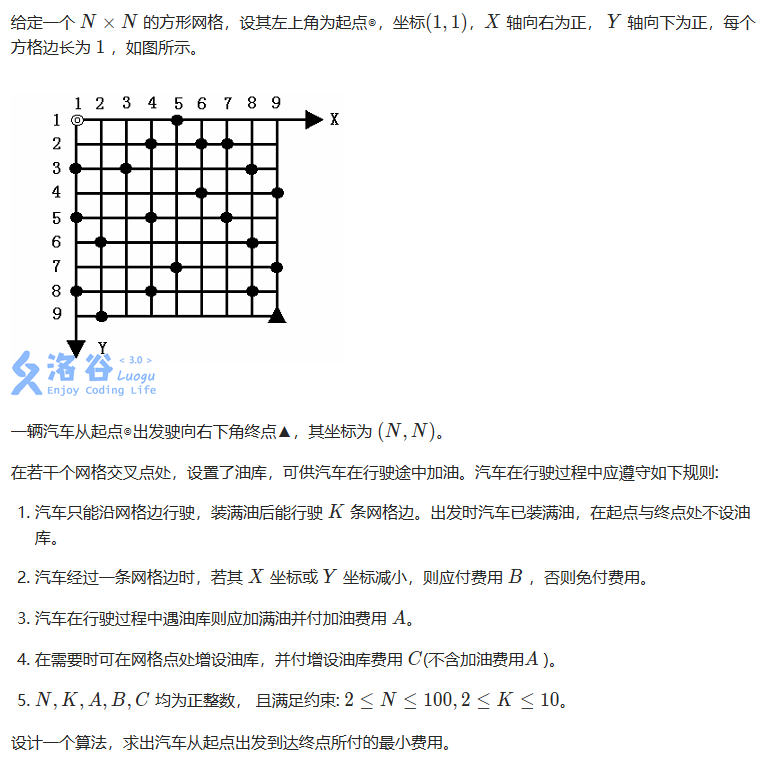 Sample Input
Sample Input
9 3 2 3 6
0 0 0 0 1 0 0 0 0
0 0 0 1 0 1 1 0 0
1 0 1 0 0 0 0 1 0
0 0 0 0 0 1 0 0 1
1 0 0 1 0 0 1 0 0
0 1 0 0 0 0 0 1 0
0 0 0 0 1 0 0 0 1
1 0 0 1 0 0 0 1 0
0 1 0 0 0 0 0 0 0
Sample Output
12
Solution
这是一道分层图最短路,到达每个点的最短路径与点的位置和剩余可走边数有关,因此分为k+1层
#include <bits/stdc++.h>
typedef long long ll;
using namespace std;
const int N = (int)100 + 2;
const int inf = 0x3f3f3f3f;
struct Point {
int x, y, k, step;
bool operator < (const Point& b) const {
return step > b.step;
}
};
int G[N][N], d[N][N][15];
const int dx[] = {-1, 0, 1, 0};
const int dy[] = {0, -1, 0, 1};
int solve(int n, int kk, int a, int b, int c) {
memset(d, 0x3f, sizeof(d));
d[1][1][kk] = 0;
priority_queue<Point> que;
que.push(Point{1, 1, kk, 0});
while(!que.empty()) {
Point ele = que.top();
que.pop();
int x = ele.x, y = ele.y, k = ele.k, step = ele.step;
if(step > d[x][y][k]) {
continue;
}
for(int j = 0; j < 4; j++) {
int nx = x + dx[j], ny = y + dy[j];
if(nx < 1 || ny < 1 || nx > n || ny > n) {
continue;
}
int nv = step + (nx < x || ny < y) * b;
if(nx == n && ny == n) {
return nv;
}
if(G[nx][ny] == 0 && d[nx][ny][kk] > nv + a + c) {
d[nx][ny][kk] = nv + a + c;
que.push(Point{nx, ny, kk, d[nx][ny][kk]});
}
if(G[nx][ny] == 0 && k - 1 > 0 && d[nx][ny][k - 1] > nv) {
d[nx][ny][k - 1] = nv;
que.push(Point{nx, ny, k - 1, nv});
}
if(G[nx][ny] == 1 && d[nx][ny][kk] > nv + a) {
d[nx][ny][kk] = nv + a;
que.push(Point{nx, ny, kk, nv + a});
}
}
}
return -1;
}
int main() {
ios::sync_with_stdio(false);
cin.tie(0);
cout.tie(0);
int n, k, a, b, c;
cin >> n >> k >> a >> b >> c;
for(int i = 1; i <= n; i++) {
for(int j = 1; j <= n; j++) {
cin >> G[i][j];
}
}
cout << solve(n, k, a, b, c) << "\n";
}
孤岛营救问题 - luogu P4011
Description
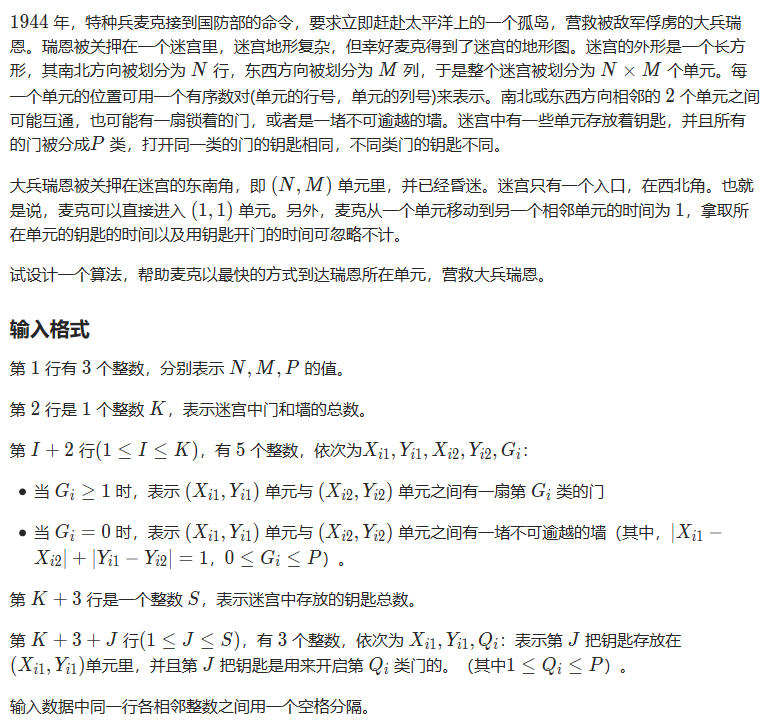 Sample Input
Sample Input
4 4 9
9
1 2 1 3 2
1 2 2 2 0
2 1 2 2 0
2 1 3 1 0
2 3 3 3 0
2 4 3 4 1
3 2 3 3 0
3 3 4 3 0
4 3 4 4 0
2
2 1 2
4 2 1
Sample Output
14
Solution
又是一道分层图最短路,而且还挺裸的
#include <bits/stdc++.h>
typedef long long ll;
using namespace std;
const int N = (int)11 + 2;
const int inf = 0x3f3f3f3f;
struct Point {
int x, y, st;
};
int G[N][N];
int info[N][N][N][N];
int key[N][N];
int step[N][N][1 << N];
const int dx[] = {-1, 0, 1, 0};
const int dy[] = {0, -1, 0, 1};
int solve(int n, int m) {
queue<Point> que;
que.push(Point{1, 1, 0});
while(!que.empty()) {
Point ele = que.front();
que.pop();
if(ele.x == n && ele.y == m) {
return step[ele.x][ele.y][ele.st];
}
for(int k = 0; k < 4; k++) {
int nx = ele.x + dx[k];
int ny = ele.y + dy[k];
if(nx < 1 || ny < 1 || nx > n || ny > m || info[ele.x][ele.y][nx][ny] == -1 ||
(info[ele.x][ele.y][nx][ny] && !(ele.st & info[ele.x][ele.y][nx][ny]))) {
continue;
}
int nst = ele.st | key[nx][ny];
if(step[nx][ny][nst]) {
continue;
}
step[nx][ny][nst] = step[ele.x][ele.y][ele.st] + 1;
que.push(Point{nx, ny, nst});
}
}
return -1;
}
int main() {
ios::sync_with_stdio(false);
cin.tie(0);
cout.tie(0);
int n, m, p, k;
cin >> n >> m >> p >> k;
while(k--) {
int x1, y1, x2, y2, g;
cin >> x1 >> y1 >> x2 >> y2 >> g;
info[x1][y1][x2][y2] = info[x2][y2][x1][y1] = (g ? (1 << g) : -1);
}
cin >> k;
while(k--) {
int x, y, g;
cin >> x >> y >> g;
key[x][y] |= (1 << g);
}
cout << solve(n, m) << "\n";
}
数字梯形问题 - luogu P4013
Description
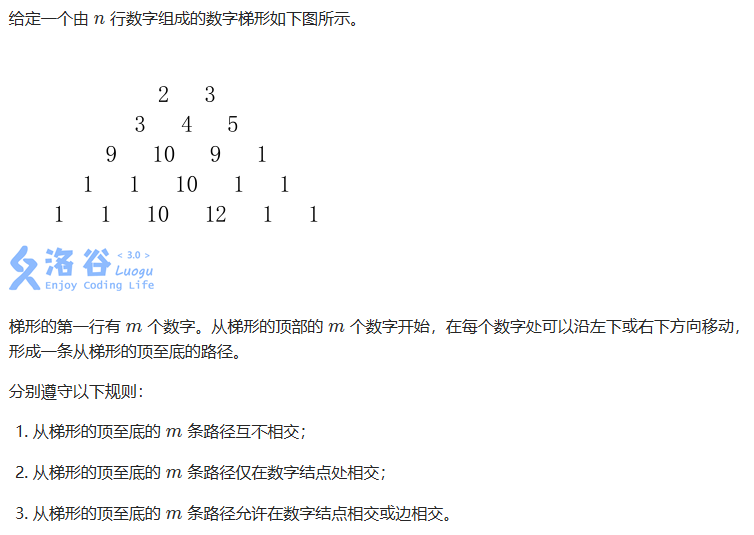 Sample Input
Sample Input
2 5
2 3
3 4 5
9 10 9 1
1 1 10 1 1
1 1 10 12 1 1
Sample Output
66
75
77
Solution
第一问:限制均不相交,意味着需要将点转为边并限制容量为1
第二问:允许在数字处相交,意味着可以把转为边的点的容量改为inf,这里注意要将连向T的点的容量也改为inf!
第三问:不拆点了直接跑(然而直接DP,岂不美哉?)
int main() {
ios::sync_with_stdio(false);
cin.tie(0);
cout.tie(0);
int n, m;
cin >> n >> m;
int sz = (2 * n + m - 1) * m / 2, ss = 0, tt = sz * 2 + 1;
for(int i = 1, k = 0; i <= m; i++) {
for(int j = 1; j <= i + n - 1; j++) {
cin >> r[i][j];
no[i][j] = ++k;
}
}
init();
for(int i = 1; i <= m; i++) {
for(int j = 1; j <= i + n - 1; j++) {
if(i == 1) {
addEdge(ss, no[i][j], 1, 0);
}
if(i == m) {
addEdge(no[i][j] + sz, tt, 1, 0);
}
addEdge(no[i][j], no[i][j] + sz, 1, -r[i][j]);
if(i < m) {
addEdge(no[i][j] + sz, no[i + 1][j], 1, 0);
addEdge(no[i][j] + sz, no[i + 1][j + 1], 1, 0);
}
}
}
pair<ll, ll> res = solve(ss, tt, 2 * sz + 2);
cout << -res.second << "\n";
init();
for(int i = 1; i <= m; i++) {
for(int j = 1; j <= i + n - 1; j++) {
if(i == 1) {
addEdge(ss, no[i][j], 1, 0);
}
if(i == m) {
addEdge(no[i][j] + sz, tt, inf, 0);
}
addEdge(no[i][j], no[i][j] + sz, inf, -r[i][j]);
if(i < m) {
addEdge(no[i][j] + sz, no[i + 1][j], 1, 0);
addEdge(no[i][j] + sz, no[i + 1][j + 1], 1, 0);
}
}
}
res = solve(ss, tt, 2 * sz + 2);
cout << -res.second << "\n";
for(int i = m; i >= 1; i--) {
for(int j = 1; j <= i + n - 1; j++) {
r[i][j] += max(r[i + 1][j], r[i + 1][j + 1]);
}
}
cout << accumulate(r[1] + 1, r[1] + n + 1, 0LL) << "\n";
}
运输问题 - luogu P4015
Description
 Sample Input
Sample Input
2 3
220 280
170 120 210
77 39 105
150 186 122
Sample Output
48500
69140
Solution
仓库和商店一一连边,然后S和仓库连,T和商店连,跑MCMF完事,不贴代码
分配问题 - luogu P4014
Description
 Sample Input
Sample Input
5
2 2 2 1 2
2 3 1 2 4
2 0 1 1 1
2 3 4 3 3
3 2 1 2 1
Sample Output
5
14
Solution
裸的二分图带权最大匹配,不贴代码
负载平衡问题 - luogu P4016
Description
 Sample Input
Sample Input
5
17 9 14 16 4
Sample Output
11
Solution
!本题中位数才是正统解法
建图:
S -> {i}, cap = a[i] - avg, cost = 0: a[i] > avg,代表货物过多的点需要将多余的流走
{i} -> T, cap = avg - a[i], cost = 0: a[i] < avg,代表货物不足的点需要有货物流入
{i} -> {i-1, i+1}, cap = inf, cost = 1:代表货物可中转
跑MCMF即可
int main() {
ios::sync_with_stdio(false);
cin.tie(0);
cout.tie(0);
int n;
cin >> n;
for(int i = 1; i <= n; i++) {
cin >> a[i];
}
init();
int ss = 0, tt = n + 1;
int avg = accumulate(a + 1, a + 1 + n, 0) / n;
for(int i = 1; i <= n; i++) {
if(a[i] < avg) {
addEdge(i, tt, avg - a[i], 0);
} else if(a[i] > avg) {
addEdge(ss, i, a[i] - avg, 0);
}
addEdge(i, i % n + 1, inf, 1);
addEdge(i, (i + n - 2) % n + 1, inf, 1);
}
pair<ll, ll> res = solve(ss, tt, n + 2);
cout << res.second << "\n";
}
火星探险问题 - luogu P3356
Description
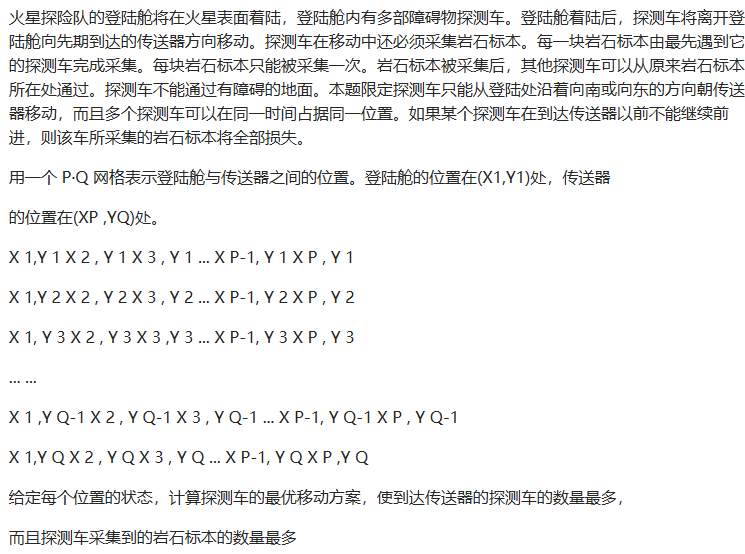 Sample Input
Sample Input
2
10
8
0 0 0 0 0 0 0 0 0 0
0 0 0 0 0 1 1 0 0 0
0 0 0 1 0 2 0 0 0 0
1 1 0 1 2 0 0 0 0 1
0 1 0 0 2 0 1 1 0 0
0 1 0 1 0 0 1 1 0 0
0 1 2 0 0 0 0 1 0 0
0 0 0 0 0 0 0 0 0 0
Sample Output
1 1
1 1
1 1
1 1
1 0
1 0
1 1
1 1
1 1
1 1
1 0
1 0
1 1
1 0
1 0
1 0
2 1
2 1
2 1
2 1
2 0
2 0
2 0
2 0
2 1
2 0
2 0
2 1
2 0
2 1
2 1
2 1
Solution
拆点为边,障碍点不建边,石块多建一条cost=-1,cap=1的边,其余正常操作
输出方案只需要沿有流量的路DFS即可
int main() {
ios::sync_with_stdio(false);
cin.tie(0);
cout.tie(0);
init();
int k, n, m;
cin >> k >> m >> n;
int sz = n * m, ss = 0, tt = sz * 2;
addEdge(ss, 1, k, 0);
for(int i = 1, tot = 0; i <= n; i++) {
for(int j = 1; j <= m; j++) {
cin >> G[i][j];
no[i][j] = ++tot;
if(G[i][j] == 0) {
addEdge(no[i][j], no[i][j] + sz, inf, 0);
}
if(G[i][j] == 2) {
addEdge(no[i][j], no[i][j] + sz, inf, 0);
addEdge(no[i][j], no[i][j] + sz, 1, -1);
}
if(i - 1 >= 1) {
addEdge(no[i - 1][j] + sz, no[i][j], inf, 0);
}
if(j - 1 >= 1) {
addEdge(no[i][j - 1] + sz, no[i][j], inf, 0);
}
}
}
auto res = solve(ss, tt, tt + 1);
for(int p = 1; p <= res.first; p++) {
int u = 1 + sz;
while(u != tt) {
for(int i = head[u]; ~i; i = e[i].nxt) {
int v = e[i].v;
if(e[i].flow < e[i].cap && v > u - sz) {
int dir = (v == u - sz + 1);
cout << p << " " << dir << "\n";
e[i].flow++;
u = v + sz;
break;
}
}
}
}
}
最长k可重区间集问题 - luogu P3358
Description
 Sample Input
Sample Input
4 2
1 7
6 8
7 10
9 13
Sample Output
15
Solution
建图
S -> {1}, cap = k, cost = 0
{i} -> {i + 1}, cap = inf, cost = 0
{li} -> {ri}, cap = 1, cost = -(ri - li)
{N} -> T, cap = k, cost = 0
可以这样想,流最大只会是k,那么其一定会优先分流到费用小的边上去,使得总费用变小(关键在于分流)
int main() {
ios::sync_with_stdio(false);
cin.tie(0);
cout.tie(0);
int n, k;
cin >> n >> k;
for(int i = 1; i <= n; i++) {
cin >> l[i] >> r[i];
mp[i] = l[i];
mp[i + n] = r[i];
}
sort(mp + 1, mp + 1 + 2 * n);
int m = unique(mp + 1, mp + 1 + 2 * n) - mp - 1;
init();
int ss = 0, tt = m + 1;
for(int i = 1; i <= n; i++) {
int u = lower_bound(mp + 1, mp + 1 + m, l[i]) - mp;
int v = lower_bound(mp + 1, mp + 1 + m, r[i]) - mp;
addEdge(u, v, 1, -r[i] + l[i]);
}
for(int i = 1; i < m; i++) {
addEdge(i, i + 1, inf, 0);
}
addEdge(ss, 1, k, 0);
addEdge(m, tt, k, 0);
auto res = solve(ss, tt, tt + 1);
cout << -res.second << "\n";
}

